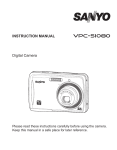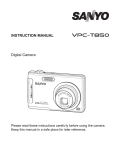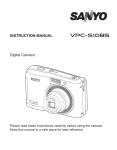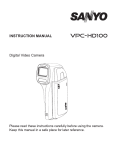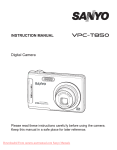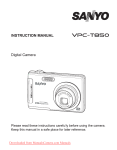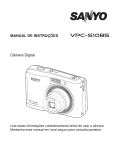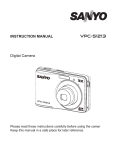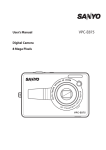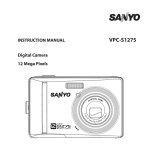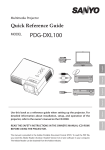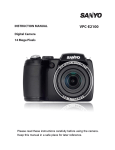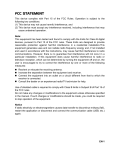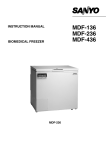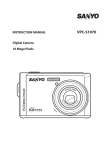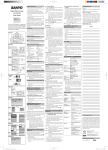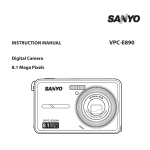Download Sanyo Xacti Vpc-S880 User's Manual
Transcript
INSTRUCTION MANUAL
Digital Camera
Please read these instructions carefully before using the camera.
Keep this manual in a safe place for later reference.
FCC STATEMENT
This device complies with Part 15 of the FCC Rules. Operation is subject to the
following two conditions:
(1) This device may not cause harmful interference, and
(2) This device must accept any interference received, including interference that may
cause undesired operation.
Note:
This equipment has been tested and found to comply with the limits for Class B digital
devices, pursuant to Part 15 of the FCC rules. These limits are designed to provide
reasonable protection against harmful interference in a residential installation.This
equipment generates uses and can radiate radio frequency energy and, if not installed
and used in accordance with the instructions, may cause harmful interference to radio
communications. However, there is no guarantee that interference will not occur in a
particular installation. If this equipment does cause harmful interference to radio or
television reception, which can be determined by turning the equipment off and on, the
user is encouraged to try to correct the interference by one or more of the following
measures:
Reorient or relocate the receiving antenna.
Increase the separation between the equipment and receiver.
Connect the equipment into an outlet on a circuit different from that to which the
receiver is connected.
Consult the dealer or an experienced radio/TV technician for help.
Use of shielded cable is required to comply with Class B limits in Subpart B of Part 15 of
the FCC rules.
Do not make any changes or modifications to the equipment unless otherwise specified
in the manual. If such changes or modifications should be made, you could be required
to stop operation of the equipment.
Notice
If static electricity or electromagnetism causes data transfer to discontinue midway (fail),
restart the application or disconnect and connect the communication cable (USB, etc.)
again.
EN-1
READ THIS FIRST
Trademark Information
Microsoft® and Windows® are U.S. registered trademarks of Microsoft Corporation.
Pentium® is a registered trademark of Intel Corporation.
Macintosh is a trademark of Apple Inc.
SD™ is a trademark.
SDHC™ is a trademark.
Other names and products may be trademarks or registered trademarks of their
respective owners.
Product Information
Product design and specifications are subject to change without notice. This
includes primary product specifications, software, software drivers, and user’s
manual. This User Manual is a general reference guide for the product.
The product and accessories that come with your camera may be different from
those described in this manual. This is due to the fact that different retailers often
specify slightly different product inclusions and accessories to suit their market
requirements, customer demographics, and geographical preferences. Products
very often vary between retailers especially with accessories such as batteries,
chargers, AC adapters, memory cards, cables, pouches, and language support.
Occasionally a retailer will specify a unique product color, appearance, and internal
memory capacity. Contact your dealer for precise product definition and included
accessories.
The illustrations in this manual are for the purpose of explanation and may differ
from the actual design of your camera.
The manufacturer assumes no liability for any errors or discrepancies in this user
manual.
EN-2
SAFETY INSTRUCTIONS
Read and understand all Warnings and Cautions before using this product.
Warnings
If foreign objects or water have entered the camera, turn the power off
and remove the batteries.
Continued use might cause fire or electric shock. Consult the store of
purchase.
If the camera has fallen or its case has been damaged, turn the power
off and remove the batteries.
Continued use might cause fire or electric shock. Consult the store of
purchase.
Do not disassemble, change or repair the camera.
This might cause fire or electric shock. For repair or internal inspection, ask
the store of purchase.
Do not use the camera in areas near water.
This might cause fire or electric shock. Take special care during rain, snow,
on the beach, or near the shore.
Do not place the camera on inclined or unstable surfaces.
This might cause the camera to fall or tilt over, causing damage.
Keep the batteries out of the reach of children.
Swallowing the batteries might cause poisoning. If the batteries are
accidentally swallowed, immediately consult a physician.
Do not use the camera while you are walking, driving or riding a
motorcycle.
This might cause you to fall over or result in traffic accident.
EN-3
Cautions
Insert the battery paying careful attention to the polarity (+ or –) of the
terminals.
Inserting the battery with its polarities inverted might cause fire and injury, or
damage to the surrounding areas due to the battery rupturing or leaking.
Do not fire the flash close to anyone’s eyes.
This might cause damage to the person’s eyesight.
Do not subject the LCD monitor to impact.
This might damage the glass on the screen or cause the internal fluid to
leak. If the internal fluid enters your eyes or comes into contact with your
body or clothes, rinse with fresh water. If the internal fluid has entered your
eyes, consult a physician to receive treatment.
A camera is a precision instrument. Do not drop it, strike it or use
excessive force when handling the camera.
This might cause damage to the camera.
Do not use the camera in humid, steamy, smoky, or dusty places.
This might cause fire or electric shock.
Do not remove the battery immediately after long period of continuous
use.
The battery becomes hot during use. Touching a hot battery might cause
burns.
Do not wrap the camera or place it in cloth or blankets.
This might cause heat to build up and deform the case, resulting in fire. Use
the camera in a well-ventilated place.
Do not leave the camera in places where the temperature may rise
significantly, such as inside a car.
This might adversely affect the case or the parts inside, resulting in fire.
Before you move the camera, disconnect cords and cables.
Failure to do this might damage cords and cables, resulting in fire and
electric shock.
EN-4
Warning:
TO PREVENT THE RISK OF FIRE OR ELECTRIC SHOCK, DO NOT EXPOSE THIS
APPLIANCE TO RAIN OR MOISTURE
FOR AMERICAN USERS
The following advisory is included in accordance with the laws of the State of California
(USA):
WARNING:
This product contains chemicals, including lead, known to the States of California to
cause cancer, birth defects or other reproductive harm. Wash hands after handling.
This equipment has been tested and found to comply with the limits for a Class B
digital device, pursuant to Part 15 of the FCC Rules. These limits are designated to
provide reasonable protection against harmful interference in a residential
installation. This equipment generates, uses and can radiate radio frequency
energy and, if not installed and used in accordance with instructions, may cause
harmful interference to radio communications. However, there is no guarantee that
interference will not occur in a particular installation. If this equipment does cause
harmful interference to radio or television reception, which can be determined by
turning the equipment off and on, the user is encouraged to try to correct the
interference by one or more of the following measures:
* Reorient or relocate the receiving antenna.
* Increase the separation between the equipment and receiver.
* Connect the equipment into an outlet on a circuit different from that to which the
receiver is connected.
* Consult the dealer or an experienced radio/TV technician for help.
Changes or modifications not expressly approved by the party responsible for
compliance could void the user’s authority to operate the equipment.
EN-5
FOR CANADIAN USERS
This Class B digital apparatus complies with Canadian ICES-003
FOR EU USERS
Note:
This symbol mark and recycle system apply to EU countries and
do not apply to countries in other areas of the world.
Your SANYO product is designed and manufactured with high
quality materials and components which can be recycled and
reused.
This symbol means that electrical and electronic equipment, at their
end-of-life, should be disposed of separately from your household
waste.
Please dispose of the equipment at your local community waste
collection/recycling centre.
In the European Union there are separate collection systems for
used electrical and electronic products.
Please help up to conserve the environment we live in!
Manufacturer and Address
SANYO Electric Co., Ltd.
5-5, Keihan-hondori, 2-chome,
Moriguchi City, Osaka, Japan
Authorized Representative and Address
SANYO FISHER Sales (Europe) GmbH
Stahlgruberring 4, D-81829 Munich, Germany
EN-6
Symbols used in this manual
Points giving some extended instructions or special points to pay attention to.
You many find the answers to questions or problems concerning camera operation in
the sections “Troubleshooting”.
FCC information
Tested To Comply
With FCC Standards
FOR HOME OR OFFICE USE
Declaration of Conformity
Model number: VPC-S880
Trade Name: SANYO
Responsible party: SANYO FISHER COMPANY
Address: 21605 Plummer Street
Chatsworth, California 91311
Telephone No.: (818) 998-7322
This device complies with Part 15 of the FCC Rules. Operation is subject to the
following two conditions:
(1) this device may not cause harmful interference, and
(2) this device must accept any interference received, including interference that
may cause undesired operation.
Canadian ICES-003 information
This class B digital apparatus complies with Canadian ICES-003.
EN-7
Notes on Battery Usage
When you use the batteries, carefully read and strictly observe the Safety Instructions
and the notes described below:
Use only the specified batteries.
Avoid extremely cold environments as low temperatures can shorten the battery life
and reduce camera performance. Therefore Ni-MH rechargeable batteries are
highly recommended.
When you are using a new rechargeable batteries or rechargeable batteries that
have not been used for an extended period of time (the batteries that passed the
expiry date are exception), it may affect the number of images that can be captured.
Therefore, to maximize their performance and lifetime, we recommend that you fully
charge the batteries and discharge them for at least one complete cycle before use.
The batteries may feel warm after a long period of continuous use of the camera or
the flash. This is normal and not a malfunction.
The camera may feel warm after a long period of continuous use. This is normal and
not a malfunction.
If the batteries are not to be used for a long period of time, remove them from the
camera to prevent leakage or corrosion and store them after no battery power is left.
Stored for a long time in a fully charged condition, their performance may be
impaired.
Always keep the battery terminals clean.
There is a risk of explosion if the batteries are replaced by an incorrect type.
Dispose of used batteries according to the recycle instructions.
Charge the rechargeable batteries fully before using for the first time.
Never use batteries of different types (together) or mix old and new batteries.
Never use manganese batteries.
To prevent short-circuiting or fire, keep the batteries away from other metal objects
when carrying or storing.
EN-8
CONTENTS
10 INTRODUCTION
10 Overview
10 Package Contents
11 GETTING TO KNOW YOUR
CAMERA
11 Front View
12 Rear View
13 LCD Monitor Display
35 EDITING SOFTWARE
INSTALLATION
36 SPECIFICATIONS
37 APPENDIX
37 Possible Number of Shots
38 Troubleshooting
39 Connecting to a PictBridge
Compatible Printer
15 GETTING START
15 Preparation
16 Initial Settings
18 CAPTURE MODE
18 Capturing Images
19 Recording Shots using Face
Detection Technology
20 Setting the Scene Mode
22 Panorama Mode
23 VIDEO MODE
23 Recording Video Clips
23 Playing Back Video Clips
24 PLAYBACK MODE
24
25
25
26
27
Playing Back Still Images
Thumbnail Display
Removing Red-eye
Protecting Images
Erasing Images
28 MENU OPTIONS
28
30
31
32
Capture Menu
Video Menu
Playback Menu
Setup Menu
34 TRANSFERRING FILES TO
YOUR COMPUTER
34 Downloading Your Files
EN-9
INTRODUCTION
Overview
Congratulations on your purchase of the new digital camera.
Capturing high-quality digital images is fast and easy with this state-of-the-art smart
camera. Equipped with an 8.1-megapixel sensor, this camera is capable of capturing
images with a resolution of up to 3264 x 2448 pixels.
Package Contents
Carefully unpack your camera and ensure that you have the following items:
Common Product Components:
Digital camera
Software CD-ROM
USB cable
Camera strap
Camera pouch
2 x AA size batteries
Instruction manual
Optional Accessory:
SD/SDHC memory card
Accessories and components may vary by retailer.
EN-10
GETTING TO KNOW YOUR CAMERA
Front View
1
2 3
4
5
6
7
1. Shutter button
2. Power button
3. Status LED
4. Flash
5. Self-timer LED
6. Microphone
7. Lens
EN-11
Rear View
2
1
3
4
5
6
7
10
9
1. LCD monitor
2.
Zoom in button
Zoom out button
8
6. SET/DISPLAY Set / Display / Scene
mode button
7. Strap holder
3. MENU Menu button
8. Battery / Memory card cover
4. MODE Mode button
Capture mode
S Video mode
x Playback mode
9. USB connector
5. 4-way control button
S Up button
m Focus button
X Right button
X Flash button
T Down button
%F Self-timer/Delete button
W Left button
[ Backlight/Exposure
compensation button
EN-12
10. Tripod socket
LCD Monitor Display
1
2
3
4
Capture Mode
1. Scene mode
2. Flash mode
[Z] Auto Flash
[Y] Red-eye Reduction
[X] Forced Flash
[W] Flash Off
3. Zoom status
4. Battery condition
[D] Full battery power
[C] Medium battery power
[B] Low battery power
[A] No battery power
5. Storage media
[}] Internal memory (no card)
[{] SD/SDHC memory card
6. Capture Mode
[Blank] Single
[
] Cont.
[
] AEB
7. Image size resolution
[8M] 8M (3264 x 2448 pixels)
[6M] 6M (2816 x 2112 pixels)
[4M] 4M (2272 x 1704 pixels)
[2M] 2M (1600 x 1200 pixels)
[0.3M] 0.3M (640 x 480 pixels)
8. Image quality
[
] Fine
[
] Normal
[
] Economy
9. Available number of shots
10. Main focus area
11. Date
12. Self-timer icon
[%2s]
2 sec.
[%10s] 10 sec.
[%10+2s] 10+2 sec.
5
18
17
6
16
15
14
13
8M
7
00154
8
9
10s
ISO
2008/01/01
100
12
11
10
13. ISO
14. []] Backlight correction
[[] Exposure compensation
15. Slow shutter warning
* Poor lighting conditions.
Images will be vulnerable to vibration.
16. Metering
[o] Average
[q] Spot
17. W.Balance
[Blank] Auto
[f] Incand.
[h] Fl1
[i] Fl2
[c] Daylight
[d] Cloudy
[ ] Manual
18. Focus setting
[Blank] Auto focus
[
] Face detection
[ m ] Macro
[
] Infinity
EN-13
Video mode [S]
1. Mode icon
2. Zoom status
3. Battery condition
4. Storage media
5. Video resolution
6. Available recording time/Elapsed time
7. Main focus area
8. Date
9. Self-timer icon
10. Focus setting
1
2
4
10
Playback mode [x] - Still image playback
VGA
5
03:50
6
10s
2008/01/01
9
1.
2.
3.
4.
3
8
7
1
Mode icon
File number
Folder number
Protect icon
100-0001
4
Playback mode [x] - Video playback
1.
2.
3.
4.
5.
6.
7.
8.
Total recorded time
Video status bar
Elapsed time
File number
Folder number
Protect icon
Mode icon
Play mode
1
8
2
3
Total
00:51
Play
00:25
100-0001
X
EN-14
3
2
7
6
5
4
GETTING START
Preparation
1. Attach the camera strap.
2. Open the battery/memory card cover.
3. Load the supplied batteries with correct
orientation as shown.
4. Insert an SD/SDHC memory card (Optional).
The camera has 16MB internal memory
(12MB available for image storage), but
you can load an SD/SDHC memory card to
expand the camera’s memory capacity.
Be sure to format the memory card with
this camera before its initial usage.
5. Close the battery/memory card cover and
make sure it is locked securely.
To prevent valuable data from being accidentally erased from an SD/
SDHC memory card, you can slide the write protect tab (on the side of
the SD/SDHC memory card) to “LOCK”.
To save, edit, or erase data on an SD/SDHC memory card, you must
unlock the card.
To prevent damaging of an SD/SDHC memory card, be sure to turn off
the power when inserting or removing the SD/SDHC memory card. If
inserting or removing the SD/SDHC memory card with the power on, the camera will automatically turn off.
Be careful not to drop the batteries when opening or closing the battery cover.
EN-15
Initial Settings
Setting the Date and Time
The date/time needs to be set if and when:
Camera is turned on for the first time.
Camera is turned on after leaving the camera without the battery for an extended
period of time.
Follow these steps to set the correct date and time:
1. Press the Power button to turn the power on.
2. Press the MODE button to set the camera
mode to [ ] / [S].
In the [ ] Capture mode, the LCD
monitor display is followed by the scene
mode setting.
3. Press the MENU button
4. Select [Setup] with the f button.
5. Select [Date/Time] with the c / d buttons,
and press the SET/DISPLAY button.
6. Select the date type with the c / d buttons,
and press the SET/DISPLAY button.
Select the item’s field with the e / f
buttons and adjust the value for the date
and time with the c / d buttons.
The time is displayed in 24-hour format.
After confirming all settings are correct,
press the SET/DISPLAY button.
7. To exit from the [Setup] menu, press the
MENU button.
EN-16
Setup
Beep
Date/Time
Language
Fr.No.Reset
LCD Bright.
Auto Off
On
Next Menu
English
Next Menu
0
3 Min.
MENU:Exit
SET:Adj.
Setup
Date/Time
2008 / 01 / 01
00 : 00
MENU:Exit
SET:Enter
Choosing the Language
Specify in which language menus and messages are to be displayed on the LCD monitor.
1. Set the camera mode to [ ] / [S].
You may set the language from the playback mode.
2. Press the MENU button.
3. Select [Setup] menu with the f button.
4. Select [Language] with the c / d buttons, and
press the SET/DISPLAY button.
The Language setting screen will be
displayed.
5. Select the displayed language with the c / d
buttons, and press the SET/DISPLAY button.
The setting will be stored.
Setup
Beep
Date/Time
Language
Fr.No.Reset
LCD Bright.
Auto Off
MENU:Exit
On
Next Menu
English
Next Menu
0
3 Min.
SET:Adj.
Formatting the Memory Card or Internal Memory
This utility formats the internal memory (or memory card) and erases all stored images
and data.
1.
2.
3.
4.
Set the camera mode to [x].
Press the MENU button
Select [Setup] menu with the f button.
Select [Format] with the c / d buttons, and
press the SET/DISPLAY button.
5. Select [Execute] with the c / d buttons, and
press the SET/DISPLAY button.
To cancel formatting, select [Cancel] and
press the SET/DISPLAY button.
Setup
Beep
Format
Fr.No.Reset
Media Info.
Sys. Info.
Language
MENU:Exit
On
Next Menu
Next Menu
Next Menu
Next Menu
English
SET:Adj.
EN-17
CAPTURE MODE
Capturing Images
Your camera is equipped with a 2.8" full color TFT LCD monitor to help you compose
images, playback recorded images/video clips or adjust menu settings.
1. Press the Power button to turn the power on.
The status LED lights green and the camera is initiated.
2. Set the camera mode to [ ].
3. Compose your image in the LCD monitor.
Pressing the
button zooms in on the subject, and enlarges the subject on
the LCD monitor.
Pressing the
button provides a wider angle image.
4. Press the shutter button.
1
2
Pressing the shutter button down halfway
automatically focuses and adjusts the
exposure, and pressing the shutter button
down fully captures the images.
The focus area frame turns blue when the
camera is in focus and the exposure is
calculated.
When the focus or exposure is not
suitable, the frame of the focus area turns
yellow.
EN-18
Recording Shots using Face Detection Technology
Face Detection Technology can identify and focus on the human faces in the image.
This advanced function simultaneously detects up to 5 human faces regardless of
their position in the scene.
White frame
Face detection function is on
Green frame
Focus lock
Out of focus
1. Set the camera mode to [ ].
2. Toggle the m
button until [ ] icon appears on the LCD monitor.
The white frame is identified as the “top priority” face (main focus frame), and
gray ones around the other faces.
3. Press the shutter button halfway down to lock the focus.
The main focus frame simultaneously turns green.
If the “top priority” face is out of focus, the main focus frame turns red.
4. Press the shutter button down fully to capture your image.
Subjects that are not suitable with this function:
a. A person wearing glasses, sunglasses, or face covered with hat or hair.
b. A person turning sideways.
EN-19
Setting the Scene Mode
By simply selecting one of the following 20 modes, you can capture the image with the
most appropriate settings.
1. Set the camera mode to [ ].
2. Press the SET/DISPLAY button.
Sports
07/20
MENU:Exit SET:OK
3. Select the desired scene mode with the e / f buttons, and press the SET/
DISPLAY button.
4. Compose the image and press the shutter button.
The table below will help you choose the appropriate scene mode:
Scene mode Description
P Program AE This mode allows you to manually set parameters other than the
shutter speed and the aperture value.
i Panorama
Select this mode when you want to capture a series of shots then
stitch them together with software to make a single photo.
n Anti-Shake
This mode minimizes the influences of hand shaking when you want
to capture an image.
Portrait Man Select this mode when you want to capture an image that makes a
man stand out against a blurred background.
Portrait Lady Select this mode when you want to capture an image that makes a
lady stand out against a blurred background.
l Landscape
Select this mode when you want to capture an image with infinity
focus, hard sharpness and high saturation.
l Sports
Select this mode when you want to capture fast-moving subjects.
g Night Portrait Select this mode when you want to capture people with an evening
or night scene background.
h Night Scene Select this mode when you want to capture dark scenes such as
night views.
EN-20
Scene mode
Description
c Candlelight Select this mode when you want to capture photos of candlelit
scene, without spoiling the ambience.
d Fireworks
Select this mode when you want to capture fireworks clearly with
optimal exposure. The shutter speed becomes slower, so using a
tripod is recommended.
| Text
Select this mode when you want to capture an image that contains
black and white subjects like printed documents.
e Sunset
Select this mode when you want to capture a sunset. This mode
helps keep the deep hues in the scene.
m Sunrise
Select this mode when you want to capture a sunrise. This mode
helps keep the deep hues in the scene.
k Splash Water Select this mode when you want to capture photos of splashing
water.
e Flow Water Select this mode when you want to capture the soft flowing water.
_ Snow
Beach
a Pets
Select this mode when you want to capture clear snow scenes
without darkened subjects and bluish tint.
Select this mode when you want to capture bright beach scenes and
sunlit water surfaces.
Select this mode when you want to capture your pets. Shoot from
their eye level.
\ User Setting This mode allows you to manually set your favorite parameters and
these settings will be memorized.
EN-21
Panorama Mode
This mode is designed to make it easier to take a series of shots then stitch them
together with software to make a single photo. You can capture a photographic subject
that won't fit into a single frame, such as a landscape, and stitch it together later with a
program such as Cool 360 or Photoshop application.
1.
2.
3.
4.
Set the camera mode to [ ].
Press the SET/DISPLAY button.
Select [Panorama] with the e / f buttons, and press the SET/DISPLAY button.
Shoot the first image.
The next image appears beside the previous image.
5. Orient the camera so that the second frame overlaps a small portion of the
photographic subject of the first image and press the shutter button to capture the
next image.
6. Follow the same steps to capture subsequent images in the sequence.
7. Finish the sequence by pressing the SET/DISPLAY button after the last image has
been recorded.
EN-22
VIDEO MODE
Recording Video Clips
This mode allows you to record video clips at a resolution of 320 x 240 / 640 x 480 pixels.
Voice can also be recorded.
1. Set the camera mode to [w].
2. Compose the image.
3. Press the shutter button.
The recording of the video clip will start.
Pressing the shutter button one more time
will end the recording of the video clip.
The recording time depends on the
storage size and the subject of the
image to be recorded.
The zoom function cannot be used
during video recording.
When recording a video clip, the flash cannot be used.
If the write speed of your SD/SDHC memory card is not fast enough for recording video clips in
the currently selected size, and then the video recording will stop. In this case, select a video
size lower than the current one.
Playing Back Video Clips
You can play back recorded video clips on the camera.
1. Set the camera mode to [x].
The last image appears on the screen.
2. Select the desired video clip with the e / f buttons.
3. Press the SET/DISPLAY button.
A press of the f / e buttons during playback allows fast forward play/fast
reverse play.
To stop video playback, press the d button.
This stops playback and returns to the start of the video clip.
To pause video playback, press the SET/DISPLAY button.
This pauses video playback.
To cancel pause, press the SET/DISPLAY button again.
Video clips cannot be displayed rotated or enlarged.
This camera does not have a built-in speaker so that you can not play back sound with the
camera. To play the video clip back on your computer, you may use either Windows Media
Player or Apple “QuickTime Player”.
QuickTime basic player is available free of charge, compatible with Mac and Windows-computers
and can be downloaded from the Apple web site at www.apple.com. For help using QuickTime
Player usage, please refer to the QuickTime on-line help for more information.
EN-23
PLAYBACK MODE
Playing Back Still Images
You can play back the still images on the LCD monitor.
1. Set the camera mode to [x].
The last image appears on the screen.
2. The images can be displayed in reverse or
forward sequence with the e / f buttons.
To view the previous image, press the e
button.
To view the next image, press the f button.
Pressing the
button enlarges the image.
To return to normal magnification, press the
button.
x1.5
An [S] icon is displayed with the video data.
EN-24
Thumbnail Display
This function allows you to view 9 thumbnail images on the LCD monitor at the same
time, which can let you quickly search for the image that you want.
1. Set the camera mode to [x].
The last image appears on the screen.
2. Press the
button.
The images are displayed in the thumbnail
display.
Images that have been selected with the e
/ f / c / d buttons will be indicated by a
yellow frame.
When there are ten or more images, scroll
the screen with the c / d buttons.
3. Press the e / f / c / d buttons to select the image to be displayed at regular size.
4. Press the SET/DISPLAY button.
The selected image is displayed at its regular size.
In the 9-thumbnail mode, an [z], [S] icon may be displayed in a thumbnail.
Removing Red-eye
You can use this function to remove the red-eye effect after an image is taken.
1. Set the camera mode to [x].
Play
2. Select the image that you want to edit with the
Fix Red Eyes Next Menu
e / f buttons.
Slide Show 3 sec.
3. Press the MENU button.
Next Menu
Protect
4. Select [Fix Red Eyes], and press the SET/
LCD Bright. 0
DISPLAY button.
Copy to card Next Menu
5. Select [Execute] with the c / d buttons, and
press the SET/DISPLAY button.
MENU:Exit
SET:Adj.
6. View the changes on the corrected image.
7. To save your corrected image, select
[Confirm] with the c / d buttons, and press
the SET/DISPLAY button.
When this process ends, this replaces the
original image with the corrected image.
EN-25
Protecting Images
Set the data to read-only to prevent images from being erased by mistake.
1. Set the camera mode to [x].
Play
2. Select the image that you want to protect with
Fix Red Eyes Next Menu
the e / f buttons.
Slide Show 3 sec.
3. Press the MENU button.
Next Menu
4. Select [Protect] with the c / d buttons, and
Protect
press the SET/DISPLAY button.
LCD Bright. 0
5. Select [Single] or [All] with the c / d buttons,
Copy to card Next Menu
and press the SET/DISPLAY button.
6. Select [Set] with the c / d buttons, and press
MENU:Exit
SET:Adj.
the SET/DISPLAY button.
Play
Protection is applied to the image and the
camera returns to the previous menu mode.
The protect icon [y] is displayed with
Single
protected images.
All
When [All] has been selected, [y] is displayed
Select
with all the images.
Canceling the Protection
MENU:Exit
SET:Enter
To cancel protection for only one image, display
the image on which you want to remove the image
protection.
Protect
1. Select [Protect] with the c / d buttons from the
Single
playback menu, and press the SET/DISPLAY
Set
button.
Cancel Protect
2. Select [Single] or [All] with the c / d buttons,
Exit
and press the SET/DISPLAY button.
MENU:Exit
SET:Enter
3. Select [Cancel Protect] with the c / d buttons,
and press the SET/DISPLAY button.
The removal of image protection is executed and the camera returns to the
previous menu mode.
Protecting multiple images simultaneously
1. Select [Protect] with the c / d buttons from the playback menu, and press the SET/
DISPLAY button.
2. Select [Select] with the c / d buttons, and press the SET/DISPLAY button.
The images are displayed in the thumbnail display.
3. Select the images you want to protect with the e / f / c / d buttons, and press the d button.
The protect icon [y] is displayed with protected images. Selecting a protected
image and pressing the d button again will cancel the protection. This
procedure is repeated to select multiple images.
4. Press the SET/DISPLAY button.
Protection and cancellation of the protection are executed and the camera
returns to playback mode.
Formatting an SD/SDHC memory card or internal memory overrides protection, and erases all
images regardless of their protected status.
EN-26
Erasing Images
Erasing single image / Erasing all images
1. Set the camera mode to [x].
The last image will be displayed on the
screen.
2. Select the image you want to erase with the e
/ f buttons.
3. Press the %F button.
The deletion menu will be displayed.
4. Select [Single] or [All] with the c / d buttons,
and press the SET/DISPLAY button.
[Single]: Erases the selected image or the
last image.
[All]: Erases all of the images except for
the protected images.
5. Select [Execute] with the c / d buttons, and
press the SET/DISPLAY button.
To not erase, select [Cancel], and press
the SET/DISPLAY button.
Delete
Delete
Single
All
(SD Card)
MENU:Exit
SET:Enter
Deleting an image will not affect sequential image numbering. For example, if you delete image
number 240, the next captured image will be numbered 241 even though 240 no longer exists.
In other words, an image-number is retired when an image is deleted and will not be reused or
reassigned to another subsequently captured image.
EN-27
MENU OPTIONS
Capture Menu
This menu is for the basic settings to be used when capturing still images.
Capture
Size
Quality
Color
W.Blance
( Manual WB
ISO
MENU:Exit
8M
Normal
Normal
Auto
Next Menu
Auto
SET:Adj.
Capture
W Metering
Average
A Sharpness Normal
Saturation Normal
MENU:Exit
SET:Adj.
Function
CaptureMd. Single
Date Print Off
Digi. zoom Off
MENU:Exit
SET:Adj.
1. Set the camera mode to [ ].
2. Press the MENU button, and select the [Capture] / [Function] menu with the e / f
button.
3. Select the desired option item with the c / d buttons, and press the SET/DISPLAY
button to enter its respective menu.
4. Select the desired setting with the c / d buttons, and press the SET/DISPLAY
button.
5. To exit from the menu, press the MENU button.
Size
This sets the size of the image that will be captured.
* [8M] 8M (3264 x 2448 pixels)
* [6M] 6M (2816 x 2112 pixels)
* [4M] 4M (2272 x 1704 pixels)
* [2M] 2M (1600 x 1200 pixels)
* [0.3M] 0.3M (640 x 480 pixels)
Quality
This sets the quality (compression) at which the image is captured.
*[
] Fine
*[
] Normal
*[
] Economy
Color
This sets the color of the image that will be captured.
* Normal / Vivid / Sepia / B&W
W. Balance
This sets the white balance for a variety of lighting conditions and permits images to
be captured that approach the conditions that are seen by the human eye.
* [ Blank ] Auto
* [ f ] Incand.
EN-28
* [ h ] Fl1
* [ i ] Fl2
* [ c ] Daylight
* [ d ] Cloudy
*[
] Manual
Manual WB
This manually sets the white balance and stores it. Use of this is convenient when the
white balance does not offer a good match. Before selecting [Execute] and before taking
your image, place a white paper in the scene and set the white balance manually.
* Cancel / Execute
ISO
This sets the sensitivity for capturing images. When the sensitivity is raised (and the
ISO figure is increased), photography will become possible even in dark locations, but
the more pixelated (grainier) the image will appear.
* Auto / 64 / 100 / 200 / 400 / 800
Metering
This sets the metering method for calculating the exposure.
* [ o ] Average: The entire area of the screen is measured, and the exposure is
calculated.
* [ q ] Spot: A very small portion of the center of the screen is measured, and the
exposure is calculated.
Sharpness
This sets the sharpness of the image that will be captured.
* Hard / Normal / Soft
Saturation
This sets the saturation of the image that will be captured.
* High / Normal / Low
CaptureMd.
This sets the recording method at the time of capturing images.
* [Blank] Single:Captures one image at a time.
*[
] Cont.: Permits continuous capture of up to 3 images.
*[
] AEB: Permits 3 consecutive images in the order of standard exposure,
underexposure and overexposure compensation.
Date Print
The date of recording can be printed directly on the still images. This function must be
activated before the image is captured.
* On / Off
Digi. Zoom
This sets whether or not to use digital zoom at the time of photography.
* On / Off
EN-29
Video Menu
This menu is for the basic settings to be used when recording video clips.
Video
Size
Color
MENU:Exit
640 x 480
Normal
SET:Adj.
1. Set the camera mode to [ w ].
2. Press the MENU button.
3. Select the desired option item with the c / d buttons, and press the SET/DISPLAY
button to enter its respective menu.
4. Select the desired setting with the c / d buttons, and press the SET/DISPLAY
button.
5. To exit from the menu, press the MENU button.
Size
This sets the size of the video clip that will be captured.
* [VGA] 640 x 480
* [QVGA] 320 x 240
Color
This sets the color of the video clip that will be captured.
* Normal / Vivid / Sepia / B&W
EN-30
Playback Menu
In the [x] mode, choose which settings are to be used for playback.
Play
Fix Red Eyes
Slide Show
Protect
LCD Bright.
Copy to card
Next Menu
3 sec.
Next Menu
0
Next Menu
MENU:Exit
SET:Adj.
1. Set the camera mode to [x].
2. Press the MENU button.
3. Select the desired option item with the c / d buttons, and press the SET/DISPLAY
button to enter its respective menu.
4. Select the desired setting with the c / d buttons, and press the SET/DISPLAY
button.
5. To exit from the menu, press the MENU button.
Fix Red Eyes
Refer to section in this manual titled “Removing Red-eye” for further details.
Slide Show
You can play back recorded images in order automatically with a selected interval.
* 3 sec. / 5 sec. / 10 sec.
Protect
Refer to section in this manual titled “Protecting Images” for further details.
LCD Bright.
Select a brightness level for the LCD monitor.
The LCD becomes brighter with the c button and darker with the d button. The
adjustment range is from -5 to 5.
Copy to Card
Allows you to copy your files from the camera’s internal memory to an SD/SDHC
memory card. Of course, you can only do this if you have a memory card installed and
some files in internal memory.
* Cancel / Execute
EN-31
Setup Menu
Set your camera’s operating environment.
Setup
Beep
Date/Time
Language
Fr.No.Reset
LCD Bright.
Auto Off
MENU:Exit
On
Next Menu
English
Next Menu
0
3 Min.
SET:Adj.
Setup
Beep
Date/Time
Language
Fr.No.Reset
LCD Bright.
Auto Off
MENU:Exit
Setup
q Light Freq. 50 Hz
k Sys. Reset Next Menu
MENU:Exit
SET:Adj.
On
Next Menu
English
Next Menu
0
3 Min.
SET:Adj.
Beep
Format
Fr.No.Reset
Media Info.
Sys. Info.
Language
MENU:Exit
On
Next Menu
Next Menu
Next Menu
Next Menu
English
SET:Adj.
Setup
k Sys. Reset Next Menu
MENU:Exit
SET:Adj.
1.
2.
3.
4.
Set the camera mode to [ ] / [S] / [x].
Press the MENU button.
Select the [Setup] menu with the f button.
Select the desired option item with the c / d buttons, and press the SET/DISPLAY
button to enter its respective menu.
5. Select the desired setting with the c / d buttons, and press the SET/DISPLAY
button.
6. To exit from the menu, press the MENU button.
Beep
This sets whether or not to mute the camera sound each time you press the camera's
buttons.
* On / Off
Date/Time
Refer to section in this manual titled “Setting the Date and Time” for further details.
Language
Refer to section in this manual titled “Choosing the Language” for further details.
Fr. No. Reset
This creates a new folder. The captured images are recorded to the newly created
folder from number 0001.
* Cancel / Execute
EN-32
LCD Bright.
Refer to section in this manual titled “LCD Bright.” in Playback Menu for further details.
Auto Off
If no operation is performed for a specific period of time, the power to the camera is
automatically turned off. This feature is useful for reducing battery usage.
* 1 Min. / 2 Min. / 3 Min. /Off
Light Freq.
This camera supports different lighting frequencies: 50 Hz and 60 Hz. When photographing under fluorescent lighting, select the correct frequency setting depending in
your local area's voltage. This function is only effective if you set the White Balance to
Fluorescent setting.
* 50 Hz / 60 Hz
Sys. Reset
This returns all basic settings to the camera’s default settings. The time setting will not
be reset.
* Cancel / Execute
Format
Refer to section in this manual titled “Formatting the Memory Card or Internal Memory”
for further details.
Media Info.
This displays the free capacity of the internal memory or the memory card.
Sys. Info.
This displays the firmware version of the camera.
EN-33
TRANSFERRING FILES TO YOUR
COMPUTER
System Requirement
Windows
Pentium 166 MHz or higher
Windows 2000/XP/Vista
128MB RAM
128MB hard disk space
CD-ROM drive
Available USB port
Macintosh
PowerPC G3/G4/G5
OS 9.0 or later
128MB RAM
128MB hard disk space
CD-ROM drive
Available USB port
Downloading Your Files
1. Connect one end of the USB cable to an
available USB port on your computer.
2. Connect the other end of the USB cable to the
USB terminal on the camera.
3. Turn on your camera.
4. Select [PC] using the c / d buttons, and press
the SET/DISPLAY button.
5. From the Windows desktop, double click on
“My Computer”.
6. Look for a new “removable disk” icon.
This “removable disk” is actually the memory (or memory card) in your camera.
Typically, the camera will be assigned drive letter “e” or higher.
7. Double click on the removable disk and locate the DCIM folder.
8. Double click on the DCIM folder to open it to find more folders.
Your recorded images and video clips will be inside these folders.
9. Copy & Paste or Drag-N-Drop image and video files to a folder on your computer.
Mac users: Double-click the “untitled” or “unlabeled” disk drive icon on your desktop.
iPhoto may automatically launch.
EN-34
EDITING SOFTWARE INSTALLATION
There are 2 types of software that are included on the CD-ROM:
MediaOne Gallery SE - makes it the easiest way to manage and share your digital life
with family & friends. The intuitive thumbnail library automatically organizes, updates
and sorts files for the most natural way to browse your multimedia collection.
COOL 360 SE - combines ease-of-use, power and flexibility to allow even novice digital imaging enthusiasts to move beyond traditional photos into immersive imaging. Its
intuitive interface and easy-to-use wizard deliver great-looking panoramas while
advanced warping, blending and alignment tools ensure excellent results.
To install software:
1. Insert the CD-ROM that came with the camera into your CD-ROM drive.
The welcome screen appears.
2. Click the respective software name.
Follow the on-screen instructions to complete the installation.
For more information about the operation of the software, refer to its respective help documentation.
For Windows 2000/XP/Vista users, please make sure to install and use the software in
“Administrator” mode.
The software is not supported on the Mac.
COOL 360 SE is not supported by Windows Vista.
EN-35
SPECIFICATIONS
Item
Description
Image sensor
1/2.5” CCD sensor (8.1 megapixels)
Image resolution
<Still image>
3264 x 2448, 2816x2112, 2272x1704, 1600 x 1200, 640 x 480
<Video clip>
640 x 480 (24 fps), 320 x 240 (30 fps)
LCD monitor
2.8” full color TFT LCD (230K pixels)
Recording media
16MB internal memory (12MB available for image storage)
Supports SD/SDHC memory card (up to 4GB) (optional)
File format
JPEG, DCF, EXIF 2.2, AVI
Lens
3x optical zoom lens
Aperture range: 2.9 (W) - 5.2 (T)
Focal length: 5.7mm - 17.1mm
(equivalent to 34mm - 102mm on a 35mm camera)
Focus Range
Auto Focus
0.4m to infinity
Macro
Wide: 0.10m to infinity
Tele: 0.35m to infinity
Shutter speed
1/2 - 1/2000 sec.
Sensitivity
<Still image>
Auto (ISO 64-200)
Manual (ISO 64/100/200/400/800)
* Sensitivity is measured in compliance with the ISO standard
(ISO12232:2006).
Digital zoom
4x (Capture mode)
1-4x in 0.5x increment (Playback mode)
Flash effective
range
0.5m - 2.4m (Wide)
0.5m - 2.1m (Tele)
Terminal
USB 2.0
Power supply
2 x AA size batteries
Operating
environment
Temperature: 00C - 400C(320F to 1040F)
Humidity: 10% - 85%(Non-condensing)
Dimensions
Approx. 97.1 x 62.2 x 20.9 mm (without protruding parts)
Weight
Approx. 132g (without batteries and memory card)
* Design and specifications are subject to change without notice.
EN-36
APPENDIX
Possible Number of Shots
Possible number of shots (still image)
The table shows the approximate shots that you can capture at each setting based on
the capacity of the internal memory and the SD/SDHC memory card.
Size
8M
3264 x 2448
6M
2816 x 2112
4M
2272 x 1704
2M
1600 x 1200
0.3M
640 x 480
Internal
Memory 64MB
Quality
Fine
Normal
Economy
Fine
Normal
Economy
Fine
Normal
Economy
Fine
Normal
Economy
Fine
Normal
Economy
3
4
5
4
6
7
9
9
11
17
21
24
53
61
75
17
23
28
23
32
35
42
46
54
82
100
112
243
282
345
SD/SDHC memory card capacity
128MB 256MB 512MB 1GB
35
48
58
48
65
72
86
94
111
167
204
228
491
571
698
72
98
118
98
132
146
174
189
224
336
410
459
987
1148
1404
146
197
238
197
265
293
350
380
450
675
824
921
1980
2304
2816
293
395
475
396
532
588
702
762
902
1353
1650
1845
3965
4615
5640
2GB
587
791
957
793
1066
1177
1405
1527
1805
2709
3304
3694
7938
9237
11289
4GB
SDHC
1176
1585
1916
1588
2134
2357
2814
3057
3614
5422
6612
7394
15887
18486
22595
Possible recording time / sec (video clip)
SD/SDHC memory card capacity
Size
Internal
Memory
64MB
128MB
256MB
512MB
1GB
2GB
4GB
SDHC
VGA
640 x 480
00:06
00:31
01:02
02:06
04:13
08:28
16:57
33:55
QVGA
320 x 240
00:21
01:38
03:09
06:40
13:24
26:50
53:43
47:31
EN-37
Troubleshooting
Refer to the symptoms and solutions listed below before sending the camera for
repairs. If the problem persists, contact your local reseller or service center.
Solutions / Corrective
Symptom
Cause
Actions
The power does not The batteries are not loaded. Load the batteries correctly.
come on.
The batteries are exhausted. Replace with a new set of
batteries.
Long period of continuous use
The batteries or
camera feels warm. of the camera or the flash.
Even if I press the
shutter button, the
camera does not
shoot.
The shutter button is not
pressed all the way down.
Press the shutter button all the
way down.
The internal memory or
memory card does not have
any free capacity.
Insert a new memory card, or
delete unwanted files.
The flash is charging.
Wait until the status LED stops
blinking.
The memory card is
write-protected.
Remove the write-protection.
Although it is set to
auto focus, it does
not focus.
The lens is dirty.
Wipe clean with a soft, dry cloth
or lens paper.
Files cannot be
deleted.
The file is protected.
Cancel protection.
The memory card is
write-protected.
Remove the write-protection.
Cannot download
images.
The free space on the hard
Check whether the hard disk has
disk in your computer may be a space for running Windows,
insufficient.
and if the drive for loading image
files has a capacity at least that
of the memory card inserted in
the camera.
The distance to the subject is
Get your subject within the
smaller than the effective range. effective focus range.
No power supply.
EN-38
Replace with a new set of
batteries.
Connecting to a PictBridge Compatible Printer
Read this section if the model you purchased is included with the PictBridge functions.
If a printer that supports PictBridge is available, images can be printed by connecting the
digital still camera directly to the PictBridge-compatible printer without using a computer.
Connecting the camera to the printer
1. Connect one end of the USB cable to your
camera.
2. Connect the other end of the USB cable to the
USB port on the printer.
3. Turn on your camera.
4. Select [Printer] with the c / d buttons, and
press the SET/DISPLAY button.
USB
PC
Printer
Next Menu
SET:Enter
Printing images
When the camera is properly connected to a PictBridge compliant printer and set to
[Printer], the PictBridge menu is displayed on the monitor.
1. Select the item you want to configure with the
PictBridge
c / d buttons, and press the SET/DISPLAY
Images
Next Menu
button.
Date Print
Off
[Images]: Select whether you want to print
Paper Size
Default
specific image or all images. You may also
Layout
Default
select printing number for specific image.
Print
[Date Print]: According to the printer type,
select whether you want to print the image
SET:Enter
with date imprint or not.
[Paper Size]: Select the desired paper
size according to the printer type. You can select [Default], [L Format], [2L
Format], [Postcard], [Card], [10 x 15cm], [4 x 6] or [A4].
[Layout]: Select the desired printing layout according to the printer type. You
can select [Default], [1 Up], [2 Up], [3 Up], [4 Up], [Index] or [No Border].
[Print]: After all settings are configured, select this item to start printing.
2. If you select [Images] in the previous step, the
Images
figure shown on the right hand side will
Single
Next Menu
appear. Select [Single], [All] with the c / d
All
Next Menu
buttons, and press the SET/DISPLAY button.
Exit
[Single]: Select to print one specific image.
[All]: Select to print all images.
[Exit]: Exit from Images option.
SET:Enter
EN-39
3. If you select [Single] in the previous step, the
figure shown on the right hand side will appear.
Select the image that you want to print with
the e / f buttons.
Select the [Print Num] (up to 99) with the
c / d buttons.
After selecting the desired image and printing
number, press the SET/DISPLAY button to
confirm.
Single
Print Num
00
100-0001
SET:Enter
4. Select [Print] with the c / d buttons, and
press the SET/DISPLAY button to start
printing.
5. The printing starts and the figure shown on the
right hand side appears.
[COMPLETE] will be displayed
temporarily, reminding you that the printing
procedure is finished.
If a print error is detected, [PRINT
ERROR] will be displayed.
PictBridge
The image printing may be failed if the power to the camera is cut off.
EN-40
PRINTING










































